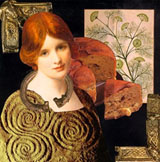February
1st is the feast day of St. Brigid. She began her life as a
pagan goddess and ended up a Christian saint. She was a fire
and fertility goddess. In her temple at Kildare, vestal
virgins tended an eternal fire. On her feast day, her statue
was washed in the sea (purification) and then carried in a
cart through the fields surrounded by candles.
Thus Brigid was a woman, a
Goddess, a Saint. Her influence blanketed over miles, warmed
thousands, and her spirited flame still lives in people today.
She is
the goddess of Poetry,
Creativity, Inspiration, Prophecy, Healing, Midwifery,
Smithcraft, Arts and Crafts, and Keeper of the Hearth -
Fire-keeper.
She is
also the Patron Saint of
babies, blacksmiths, people who work on boats or on the water,
people who make their living from the water, cattle, children whose parents are not married,
dairymaids, dairy workers, fugitives, infants, Ireland,
mariners, midwives, newborn, babies, poets, sailors,
scholars, and travellers.
Triple
Aspects
- Goddess
of Inspiration - poets, poetry, creativity, prophecy, arts
- Goddess
of Smithcraft - blacksmiths, goldsmiths, household crafts
- Goddess
of Healing - healers, medicine, spiritual healing,
fertility (crops, land, cattle)
Thus
she is the Triple Goddess
embodying Maiden - of purity and innocence, Mother - of
comfort and fruitfulness, and Crone - of wisdom and healing.
In prehistoric times, (and still now) the name, "Bhrigid"
or "Bhride" was used synonymously with the word
"Goddess".
The
following are some name variations: Brighid; Bride (Scotland),
Brid, Brigit, Bridget, Briganta (England), Brigan, Brigindo
(Gaul), Berecyntia, Brigandu (France)
Some
other meanings ascribed to Brigid are Bright One, High One,
Bright Arrow, Power.
Christianized
forms include St. Brigit (Irish), St. Ffraid (Welsh), St.
Bridget (Swedish), Queen of Heaven, Prophetess of Christ,
Mary.
Her symbols
include:
- Fire
- flames, candle crown, hearth
- Water
- cauldron, springs, wells
- Grain
- Brigid wheels, corn/oat sheaf Goddess effigy, Brigid's
Bed
- Creatures
- white cow with red ears, wolf, snake, swan and vulture
- Talismans
- Shining Mirror to Otherworld, Spinning Wheel andHoly
Grail
There is much to say about
Brigid the Goddess/Brigid the Saint. Most believe the two are one
in the same. The Saint, who came to this earth in human form
embodied the qualities of the Goddess - much in the same way
people describe Jesus the man, embodying the qualities of
Christ God.
To
celebrate St. Brigid's day, people put out a loaf of bread on
the windowsill for the Saint and an ear of corn for her white
cow, offerings for the grain goddess like the loaf buried in
the first furrow. A small quantity of special seeds are mixed
with those to be sown. Wheat stalks are woven into X-shaped
crosses to serve as charms to protect home from fire and
lightning.
In the
HIghlands, women dress the corn doll or last sheaf (from
Lammas or the autumn equinox) in a bridal gown and put her in
a basket, which is called the Bride's bed. A wand, candle or
other phallic object is laid across her and Bride is invited
to come, for her bed is ready.
One of the many things
people love about Brigid is she seems to be able to bridge the
apparently vast chasm between Christianity and Paganism. |